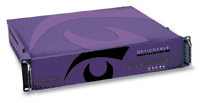Oculan's Ocustat Keeps Tabs On Network Usage
The vendor also upgraded its flagship network management platform, OpticNerve, to support the new device.
The latest offering, called OcuStat, will be sold exclusively through the channel and combines remote managed services with an appliance that collects data at the customer site. Users pay a monthly subscription fee for the service, which is primarily aimed at SMB customers.
The new appliance is an optional add-on to OpticNerve. Other add-ons include Iris, a desktop management tool that provides an audit trail of user actions and configuration changes, and EyeLid, an appliance that monitors network traffic for security threats.

\
The OcuStat appliance is an optional add-on to Oculan's Opticnerve (above).
With OcuStat, solution providers can offer customers a means of identifying and monitoring how network resources are being used, said Shane O'Donnell, CTO of Oculan.
"We used to tell you if the network was working. Now we tell you how it's working at a level most network managers, especially in the SMB space, don't have access to [through other tools," O'Donnell said.
OcuStat provides a quick view of network usage patterns, said Ken Savage, president of Waypoint Solutions, a
network integrator based in Houston. "More than 90 percent of the time, the IT staff doesn't know what their network is being used for," Savage said.
Knowing how network resources are used can help customers determine whether they need to add bandwidth or retool their usage policies, he said.
OcuStat monitors the type and quantity of traffic and applications traversing a network and identifies which users utilize the network most. It also tracks the most-visited Web sites and historical network performance trends, O'Donnell said.
For example, a customer might report that its Internet connection slows down late in the afternoon. OcuStat could determine that an employee typically downloads large music files before leaving the office, usurping critical bandwidth, O'Donnell said.
"A lot of partners have to take it at face value when a customer says the network is slow. Resellers can now [determine a network baseline," O'Donnell said. "They can talk about retooling an existing network before talking about adding thousands of dollars in new equipment."
Such network services provide partners with higher margins than equipment sales would, O'Donnell said.
OcuStat will likely appeal to smaller Oculan customers trying to cut costs, Savage said. Many larger organizations already have bandwidth management tools in place, he said.
For many customers, bandwidth management is a feature that's "nice to have," not one they "need to have," so it would not likely attract customers to the Oculan platform in and of itself, said Doug Goldstein, manager of network services at Business Integrators, a Houston-based solution provider.
Some customers will probably start with Optic-
Nerve first and then add OcuStat later, Goldstein said, adding that OcuStat may appeal most to customers running high-bandwidth services. "If they're using something like VoIP, where bandwidth is critical, that's probably the environment where OcuStat will play very nicely," he said.
To support OcuStat, Oculan also introduced Optic-
Nerve 3.1, a version that includes network vulnerability scanning and latency graphing, which polls network servers and reports on how long the system takes to respond to requests.
Version 3.1 also expands the platforms OpticNerve supports, including VPN equipment from Cisco Systems and Linux-based systems, O'Donnell said.
Pricing for OcuStat starts at $2,995 per year and requires the purchase of OpticNerve, which starts at $19,995. Volume discounts are available.